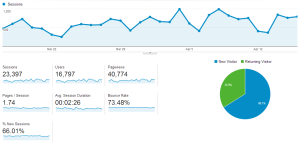We analysts enjoy crisp, objective and to the point conversations. An ideal conversation for us is when we come straight to the point, discuss and finish the conversation.
Don’t understand what I mean? Here is an example: This is a mail I received in my inbox (name of sender removed). The mail might look crisp, but it does not connect with me. Can you spot the problem?
The problem: It has absolutely no context! No Subject and a 3 word qualification of the person…that’s it. How do I help this person, even if I want to? Imagine what would I do if I am not some one inclined to help? Just delete it.
Don’t get me wrong here. I am as much an advocate of brevity as any of you are. I am not asking for a 2 page long mail here. All I am saying is providing right amount of context is critical to influence people. For example, if this person would have mentioned details like: Where has he done B.Tech. form? Which stream? What are his interests? Why does he want a job in analytics? and what all has he already tried? I could have been of more help to him.
Same principle applies to your projects / analytical work as well.
Until you provide the right details and context, it would be difficult to influence your stakeholders and business owners. In rest of this article, I explain how this principle applies to various situations in life of an analyst and then provide simple tips to overcome these situations.
[stextbox id= “section”]Case 1: A business Intelligence professional:[/stextbox]
Lets take a scenario, where you are responsible for creating dashboard and monitoring business for a e-commerce website. You have tallied your numbers across sources and put in all the hard work to make sure they are accurate. You present these absolute numbers to business users in form of a neat dashboard, but they don’t use it.
Why? You forgot to include the right context for them.
If you just provide number of sales in last month as a metric, it does not help. You need to compare this number against last year / last month / plan / benchmark. Whether is has improved / degraded? If the Sales were higher, were they because of more visitors or better conversion?
Providing these details makes your easier and more insightful to use. So, next time when you create a dashboard, ask yourself, whether you have provided enough context?
[stextbox id = “section”]Case 2: A predictive modeler:[/stextbox]
Lets take another scenario. You were asked to build next generation fraud detection model for your employer (a credit card provider). You have put in a lot of hard work and are excited about your findings. Just one final step, before you can implement the model – you need to get it approved from credit risk approval committee. You prepare your presentation making sure you explain every minute detail. But guess what? While presenting this model to the committee, you feel like you are talking to stones. No one is responding to the details you provided. Reason – they are not at same page with you.
While making any presentation, you need to start with what is in it for business users? Even if they are aware of the background, quickly recap it before you get into details. This will align everyone back to the business problem. Then, you can explain how your solution can benefit and then present the solution!
[stextbox id=”section”]2 simple tips to make more impact from your work:[/stextbox]
We come across these situations on day to day basis, where we fall short of creating the right impact because we undermine the importance of providing context. So next time when you are preparing / presenting something to your users, keep these simple tips in mind. They might look simple on the surface, but are very empowering:
- Start with the user in mind. If you follow this practice alone, you will be good in most of the cases.What are your users interested in? How aware are they? Do they have specific pain points you are aware of? Which product are they focusing on? What was the marketing campaign last month? What is the opportunity size for them? Each of these question impact what you present and how you present. So think carefully about these aspects, identify and address the needs of the customer
- Present as if you are narrating a story to a child – Visualize as if you are narrating a story to a child. What details will you include? How will you make it exciting? Include only the relevant details and pack it into a story / structure. Emphasize on aspects you want them to take away. If they are analysts, technical details will excite them more. If they are business users, details about implementation of your solution will matter more.
That’s it. Keep these simple tips in your mind and practice them every time you are talking to your business users.
What do you think about the importance of context? Do you have tips which can help to make more impact from our work? If yes, please share them through the comments below.







